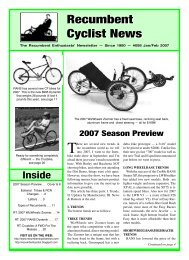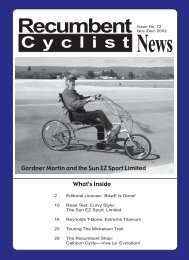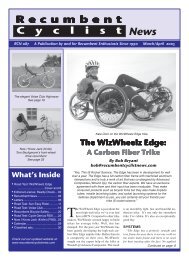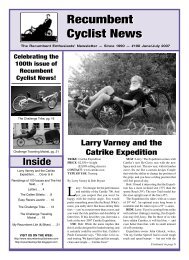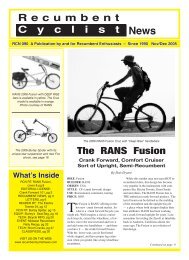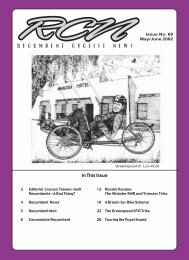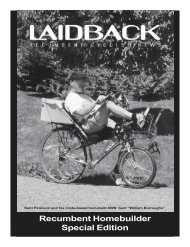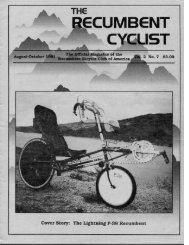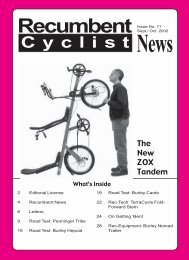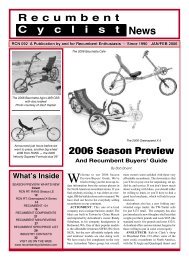C y c l i s t Recumbent - Steve Briggs
C y c l i s t Recumbent - Steve Briggs
C y c l i s t Recumbent - Steve Briggs
You also want an ePaper? Increase the reach of your titles
YUMPU automatically turns print PDFs into web optimized ePapers that Google loves.
of your helmet, so a neck rest is a more usable<br />
item. Even these can add to road vibration, but<br />
can offer some relief on very laid-back designs.<br />
GEARING<br />
Gearing is the biggest issue facing the smallwheel<br />
trike buyer. Most bicycle components<br />
are designed for bikes with 26” and 700c rear<br />
wheels. Using these components means that<br />
you’ll have very low gears, so builders must<br />
be creative to achieve adequate gearing. Low<br />
gears are not the problem, as it is easy to get a<br />
15-20” low gear for hill climbing. Getting high<br />
speed open-road gears over 100” is a problem.<br />
(Here’s the quick guide to gear-inch calculation:<br />
Low gear - inside front chainring divided<br />
by large rear cog multiplied by rear wheel diameter;<br />
High gear - outside front chainring<br />
divided by small rear cog multiplied by rear<br />
wheel diameter.) You can see how rear wheel<br />
diameter plays an important part in recumbent<br />
gearing. (See also RCN 079 page 2 and 086<br />
page 18 for more information).<br />
Those who do mostly flat bike trails can utilize<br />
a gear range from 25-30 on the low to 100-<br />
120 on the high. Those who climb steep hills,<br />
mountain passes or carry cargo will want a low<br />
gear of 15 or so gear-inches, to a high of 90 -<br />
100 gear-inches. Minimalists can easily use<br />
standard parts on trikes with small drive<br />
wheels; it just means that you can’t pedal at<br />
much more than 20 or 25 mph. Your preferences<br />
may vary depending on your trike, terrain<br />
and personal fitness.<br />
DRIVETRAIN OPTIONS<br />
Here are some creative options to achieve<br />
higher (or lower) gearing:<br />
Schlumpf: This company builds two speed<br />
bottom brackets with lower gearing (Mountain<br />
Drive) or higher gearing (Speed Drive).<br />
Schlumpf drives are shifted by a heel button<br />
on the end of the bottom bracket spindle. This<br />
is a simple, elegant and jewel-like option,<br />
though it is expensive.<br />
SRAM DualDrive: This is basically a 3-<br />
speed internal gear inside a cassette hub, making<br />
for 24-27 speeds at the rear wheel. Gear<br />
#1 is a reduction, #2 is a 1:1 and #3 is an overdrive.<br />
They add weight and complexity and<br />
are definitely less popular than five years ago<br />
(on recumbents). The trend on trikes seems to<br />
be to just live with lower gears and simpler<br />
drivetrains.<br />
Capreo: This is a Shimano component<br />
package that has been designed for bicycles<br />
with small drive wheels (16” or 20”). Instead<br />
of the traditional 11-tooth small cassette cog,<br />
the Capreo has a 9-tooth (cassette with a 9-26<br />
tooth cog range; RCN advertiser Zach Kaplan<br />
offers a custom wider range Capreo Cassette).<br />
This easily gives you higher gears. Keep in<br />
mind that small cogs wear out faster, and the<br />
Capreo cassette is relatively rare, so it might<br />
be a good idea to keep a spare. The Capreo<br />
The folks at the first Catrike Rally held in Florida this past February are having too<br />
much fun. We hope this becomes a yearly event. Photo courtesy of Larry Varney<br />
also requires a special hub, which could mean<br />
a new wheel and could cost about the same as<br />
installing a Schlumpf drive.<br />
CRANKS<br />
There is a micro-trend in recumbency to use<br />
shorter crank arms (described in RCN 086,<br />
page 18). I used to have 170mm-175mm<br />
cranks and now they feel just too long. Shorter<br />
crank arms make you spin better, require lower<br />
gearing and are easier on your knees. I am<br />
currently experimenting with 140mm cranks<br />
on my Greenspeed GT-3. Short cranks are a<br />
factory option on Greenspeed trikes.<br />
Rotor: This crankset offers a mechanical<br />
advantage to help eliminate the dead spot in<br />
your pedaling circle. Rotor cranks start at $729<br />
and are available in sizes from 165mm. For<br />
more information, see RCN 084, page 24 or<br />
www.rotorusa.com.<br />
SHIFTERS<br />
You will find two different types of shifters<br />
on recumbent trikes:<br />
SRAM Twist Grip: These shifters are popular<br />
and affordable, though they were not designed<br />
to be used in the vertical position. They<br />
require more force to shift and you must be<br />
careful not to make an unplanned steering<br />
maneuver while twisting. The lower end twist<br />
shifters (3.0, 4.0, 5.0, and possibly MRX)<br />
won’t last as long as other types of shifters.<br />
Shimano Dura Ace Bar-Ends: These<br />
shifters are time-proven and will last for years.<br />
They are mounted to the ends of the bars, facing<br />
rear or front to suit your preference. They<br />
are easy to shift have a fluid and graceful feel.<br />
The upgrade is $70-$100, but well worth it.<br />
BRAKES<br />
Several different types of brakes can be<br />
found on recumbent trikes:<br />
Drum: These brakes are incredibly simple,<br />
smooth, and offer a quiet velvety feel. The only<br />
maintenance they should require is adjustment<br />
for cable stretch. Brake pads last a long time.<br />
Braking power is not as good as with discs,<br />
but some feel that discs are really overkill on<br />
these trikes.<br />
Mechanical Disc: Discs are all the rage in<br />
MTB circles, and the buzz has now spread to<br />
recumbent trikes. These are the simplest disc<br />
brakes which are operated by a cable between<br />
the handle and caliper. They are reasonably<br />
simple to set up and adjust. They are more<br />
powerful than drum brakes, but require more<br />
maintenance and frequent adjustments. I adjust<br />
mine every two weeks with the turn of a<br />
hex wrench and spinning the wheel. The biggest<br />
problem is with rotors going out of true<br />
(we’ve had two trikes delivered with warped<br />
rotors). Working on these brakes is fairly easy,<br />
and it is recommended that you learn to do it.<br />
A warped rotor means an incorrect adjustment<br />
or a dragging disc. I like Avids and Shimanos<br />
the best, but haven’t had any problem with<br />
Hayes either. The problematic models for us<br />
have been the Promax which don’t have much<br />
adjustment range.<br />
Hydraulic Disc: These brakes have pressurized<br />
fluid in the lines which require less mechanic<br />
leverage to activate. It is also possible<br />
to connect both front brakes to one lever for<br />
equal braking pressure on the front wheels. The<br />
downside is that one must learn how to bleed<br />
the brakes and work with nasty hydraulic fluid<br />
(or make sure your local mechanic knows how<br />
to do this). While the braking power is improved<br />
with hydraulics, field service is much<br />
more difficult.<br />
Parking Brake: Some sort of parking brake<br />
is essential. ICE trikes have a spring loaded<br />
button on the brake lever. This is a most elegant<br />
and user-friendly solution. Our<br />
WizWheelz trike came with a velcro strap to<br />
wrap around the brake handle. This is simple<br />
and it works, but not as well as a button.<br />
Rear Wheel Brake: Some entry level trikes<br />
have a rear brake connected to a front brake<br />
lever, and the two front brakes connected to a<br />
single lever. If pulling equally, this can throw<br />
the trike into a spin. This could be a safety<br />
issue and is not recommended.<br />
CHAIN MANAGEMENT<br />
Methods vary for routing the chain from the<br />
May/June 2005 9



